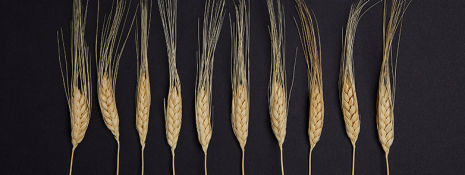The benefits of plant breeding
In the midst of today’s organic food boom and romantic glorification of nature, plant breeding is in a difficult position: one often forgets that we as humans owe our very survival to the supply of food. Almost nothing that we eat today was originally found in the natural world.

Behind the idyllic picture of every wheat field, there is actually an arms race going on between crop and disease.
iStock / Adam Smigielski / ETH Zürich

Select and refine the best: plant breeding is a guarantor of life and the key to greater sustainability in the field.
iStock / xefstock / ETH Zürich

Sick potatoe: the late blight disease.
Wikimedia / ETH Zürich

The effect of continuous selection: from the slight teosinte to massive corn cob.
Wikimedia / John Doebley / ETH Zürich




Humans can do without many things – but not food. Ultimately, every calorie we consume to provide ourselves with biochemical energy is produced by plants. Every little daisy in the world can perform photosynthesis – but we cannot. Yet even the most advanced plant breeding methods cannot transform a daisy into a source of calories. Nor should they, because a long time ago our ancestors discovered ways to exploit other plant species that are “naturally” better suited to this.
The roots of human culture
As early as 10,000 years ago, humans selected the best individual specimens from the precursors of today’s maize, wheat, rice and apples, and tried to improve or make them more resistant by “forcing” them to breed with the same or different varieties. For thousands of years, “human selection” was the law of the land. Its success led to greater yields and better tasting food.
Later, the Bible also vowed to “subdue the earth”. About 2,000 years ago, the apple tree had already become a cultivated chimerism, where the fruit-bearing stem was grafted on to the root system of a different variety – a highly advanced biotechnological process for the time. What happened?
We eat cultivated plants – not wild plants
Gradually, humans cultivated modern crops from their wild progenitors. The wheat and spelt we eat today are hybrids created from crossing the genomes of three wild species. Maize with its oversized cobs is a descendent of the shrubby teosinte. Clones of apples, vines and other fruit trees also experienced a loss of innocence, no longer forest and meadow flora, now that they were grafted on to rootstock capable of keeping soil-borne pathogens in check.
Royalty under threat
These kinds of optimised plants were a blessing at the time. Thanks to steadily increasing yields, our ancestors were able to advance both economically and culturally. The world’s population grew, and the “big three” – wheat, rice and corn – continue to provide more than half of our food today. These calorie kings cannot be replaced; we depend on them, and this has become a curse.
Our crops have a serious problem (and so do we): they must constantly fight off disease. Although the same could be said for all living things, it is particularly acute for our agricultural all-star athletes. This is because the more we grow them, the more aggressive pests and pathogens become – and the risk of disease increases.
Creating resistance
Plant breeding is one of our most important weapons in this race. It is nothing more than a highly selective dating service that creates new disease-resistant varieties through selection over many years – but only with great effort. For years, scientists have been trying to make crops permanently resistant [1] – unfortunately, to no avail. But avoidance of resistance improvement is not an option, however. Stagnation leads to regression: a future without breeding would be like a world without medicine.
This is also the reason why researchers have high hopes for modern breeding methods such as Crispr. These genome editing processes allow individual genes to be specifically modified or deactivated, without the incorporation of foreign genetic material. In turn, this enables the development of highly resistant plants that are genetically indistinguishable from conventionally bred varieties. Organic farmers may even be interested in this development [2]. Currently, they must treat potatoes with large amounts of copper in order to keep late blight in check, for example. A resistant variety would be a blessing, even if it came about through genome editing.
The right path to more sustainability
So let’s not fool ourselves: almost nothing we eat today, whether organic or conventional, was found in nature 10,000 years ago. Today’s major crop varieties must be adapted to survive in a changing environment. Not from year to year – but in increasingly rapid succession.
Our fields will also need to become diversified: we need more plant species if we are to feed the world, and we need more resistant varieties of these species. Moreover, the varieties must be of top quality and yield, conserve soil and water, and require as little fertiliser and pesticides as possible. This ideal path towards sustainable agriculture will need both new plant breeding methods and ecological cultivation of our crops. These are not mutually exclusive – rather, they are complementary.





























































